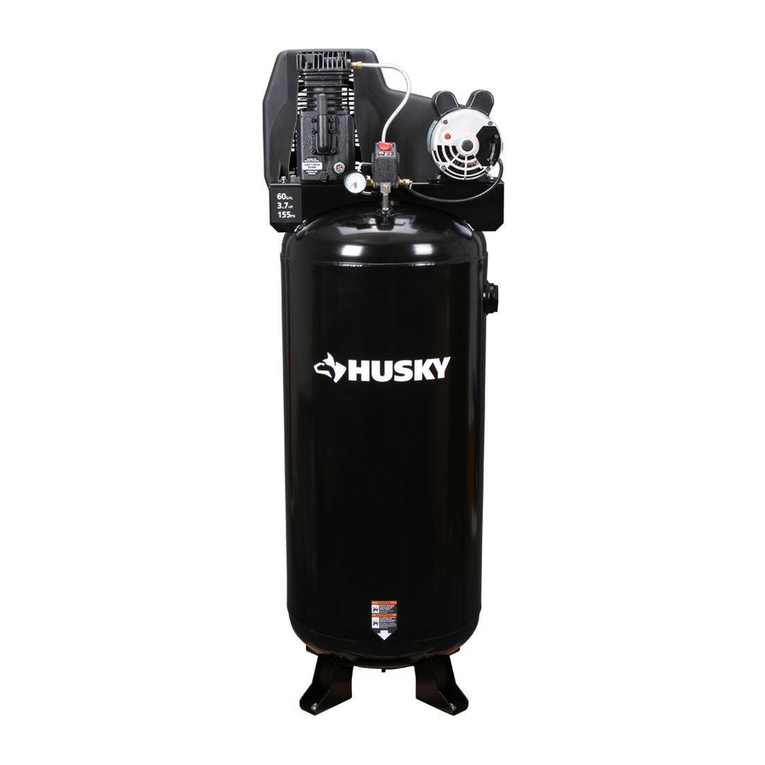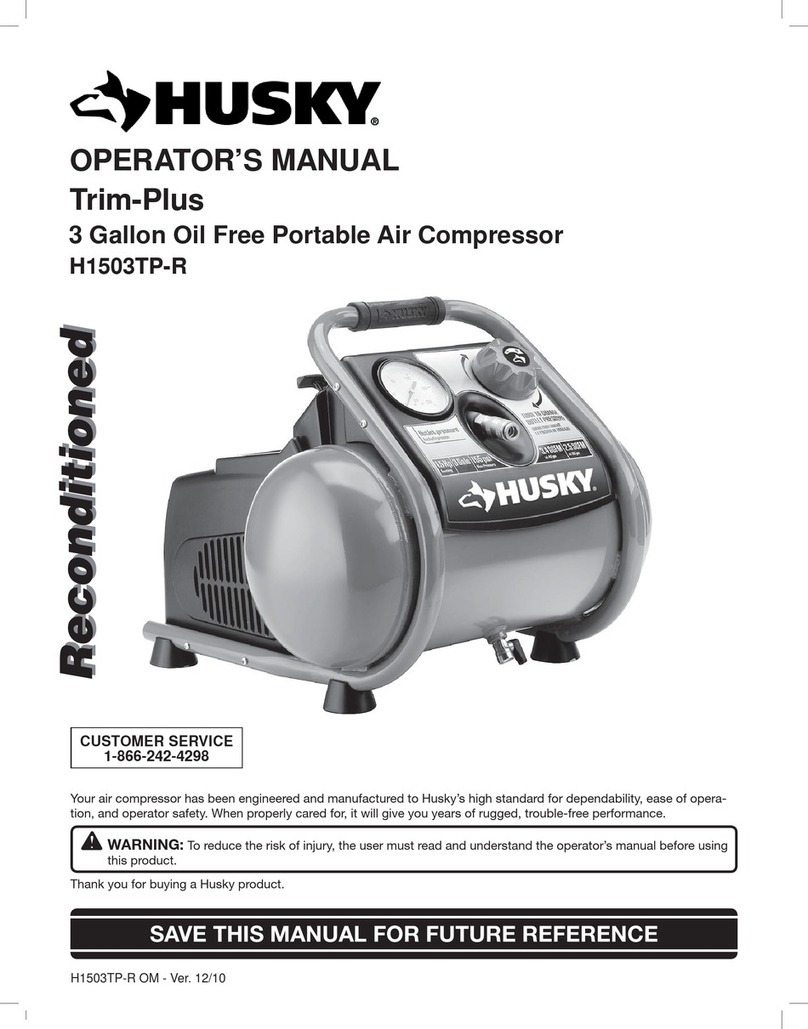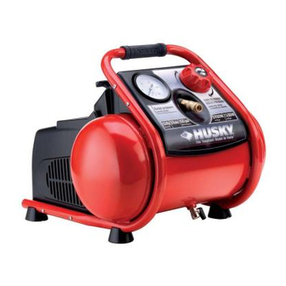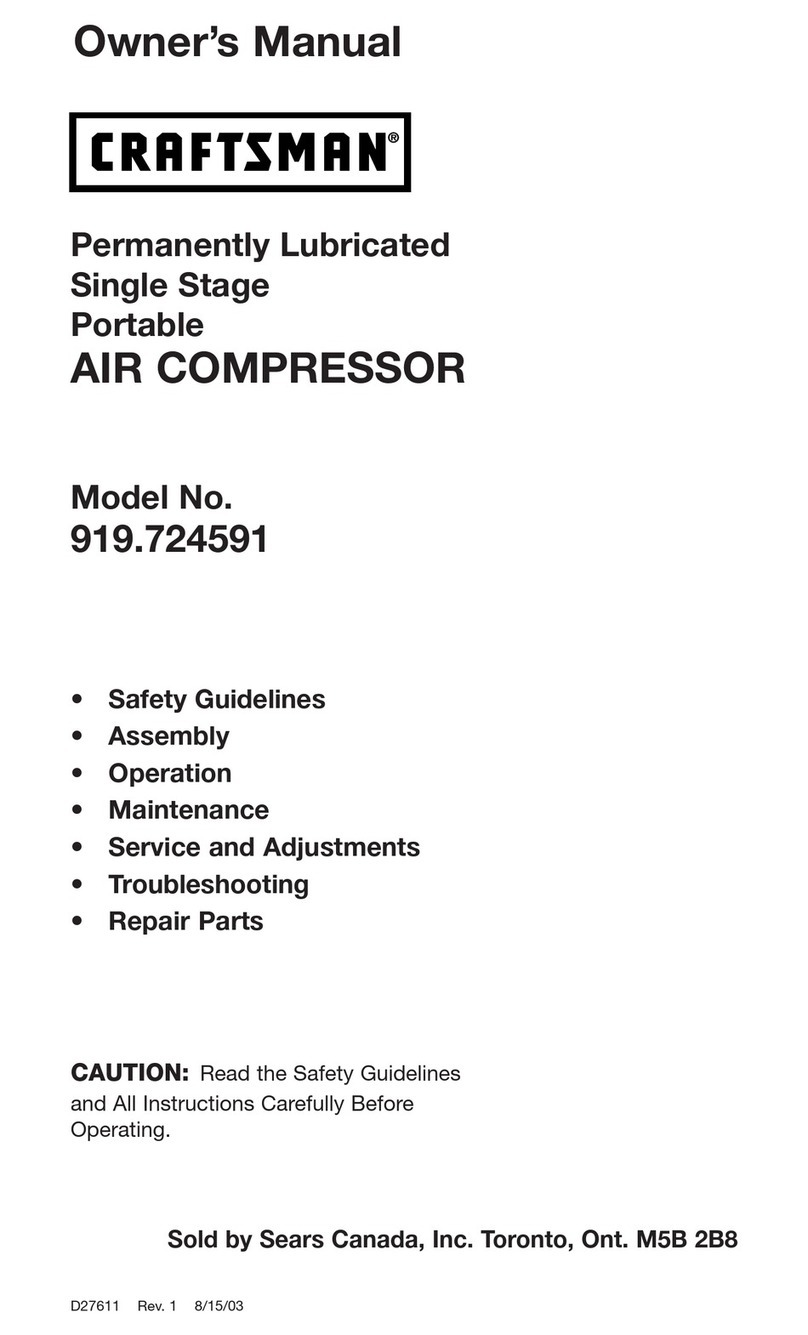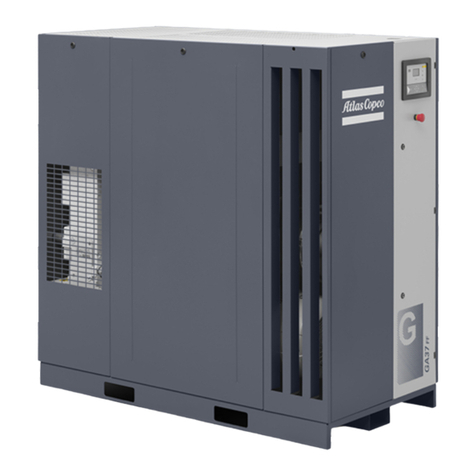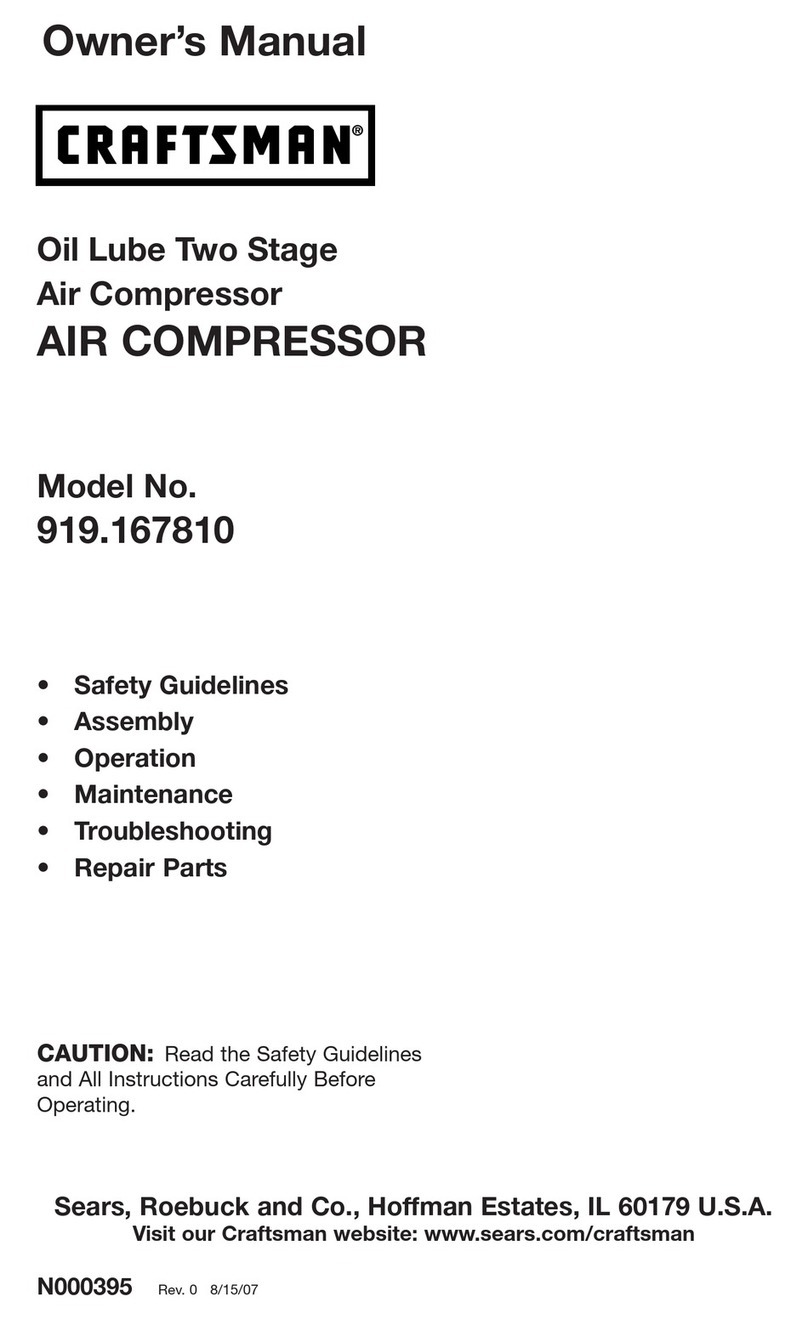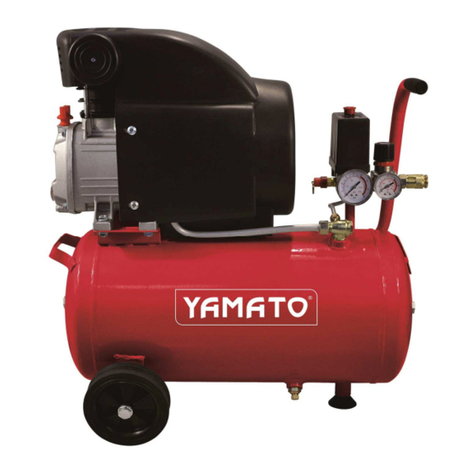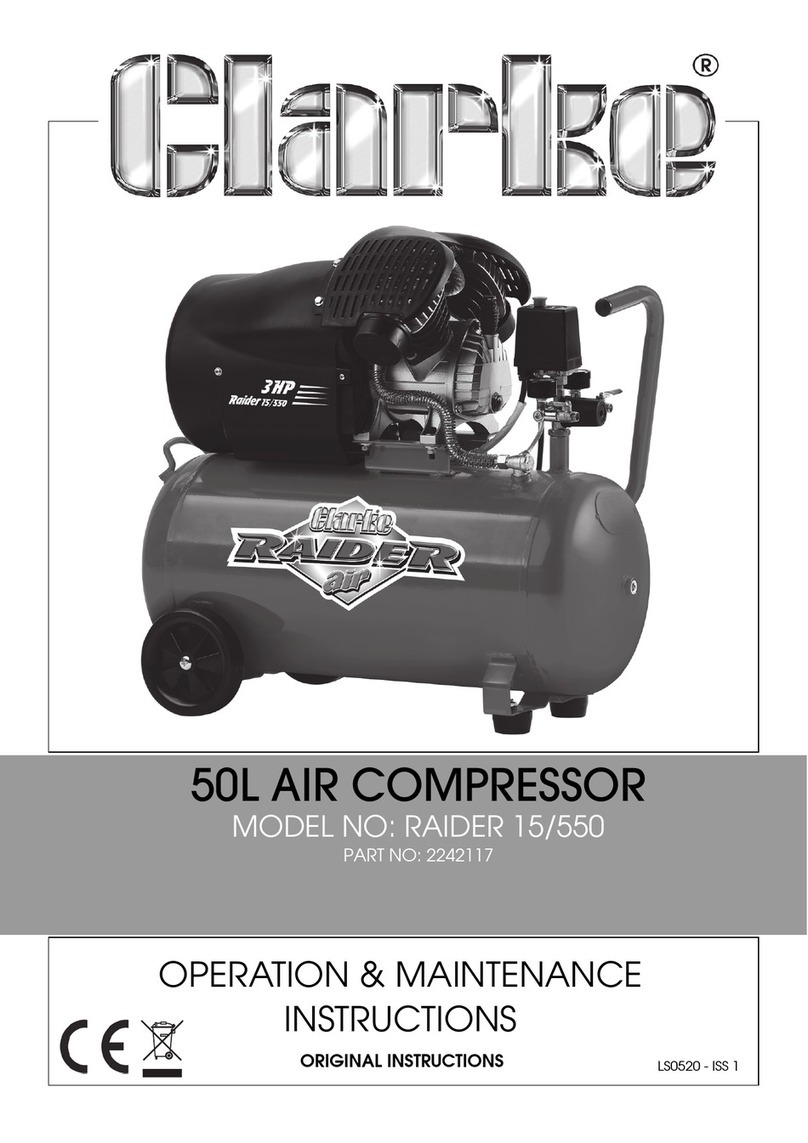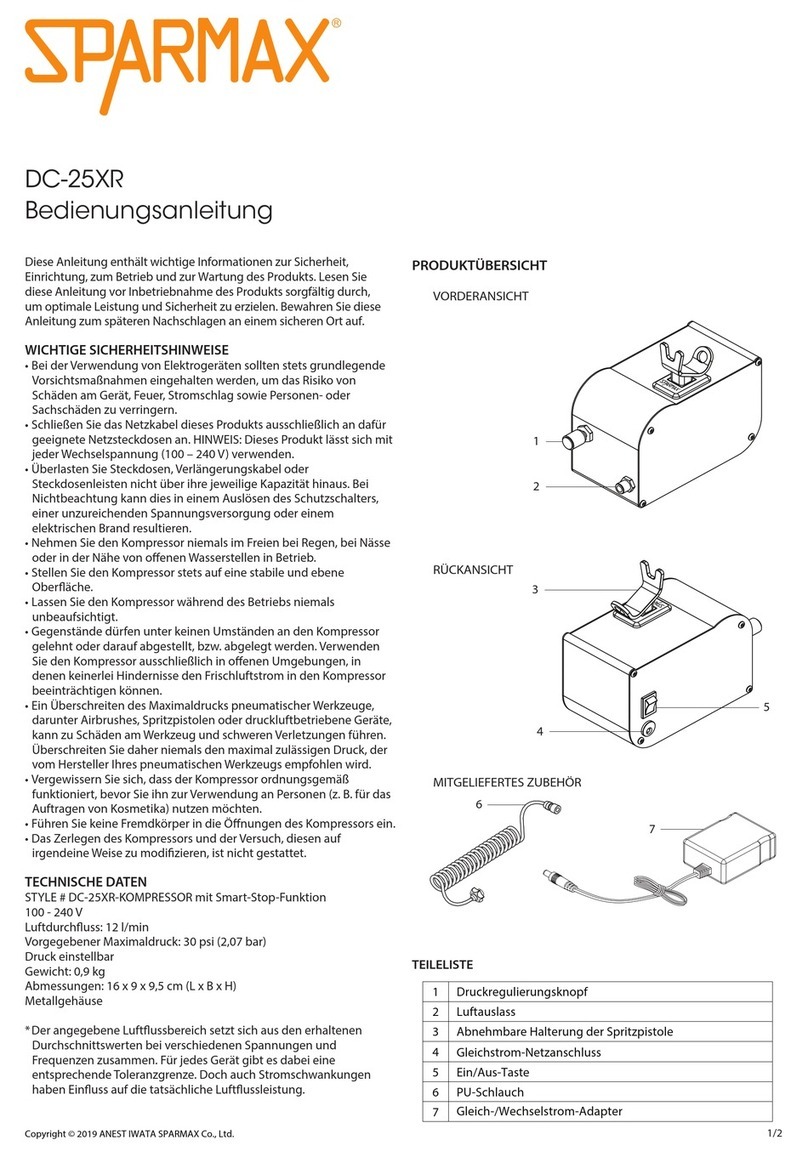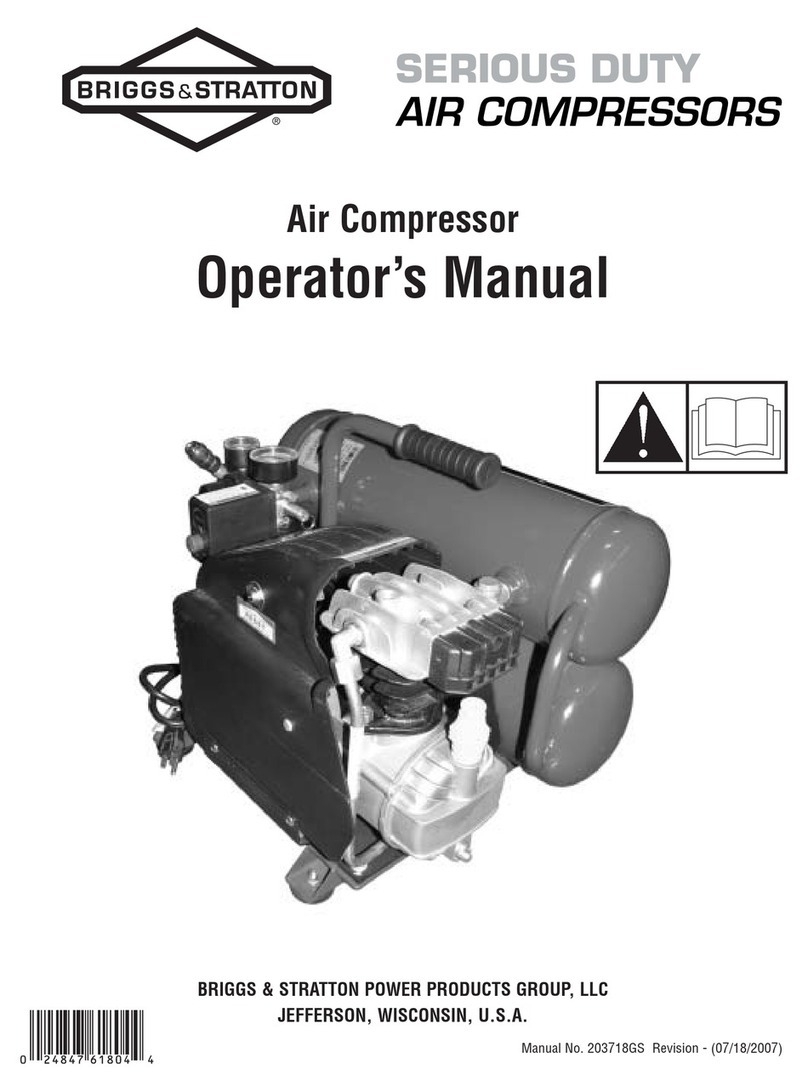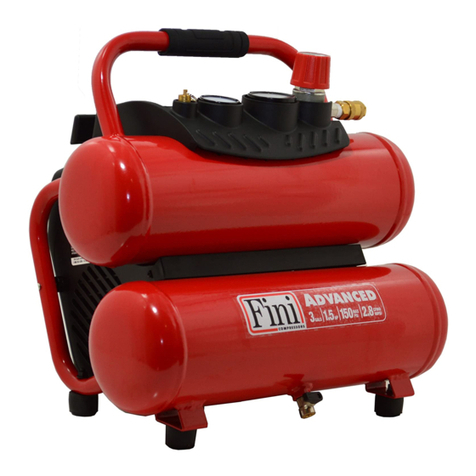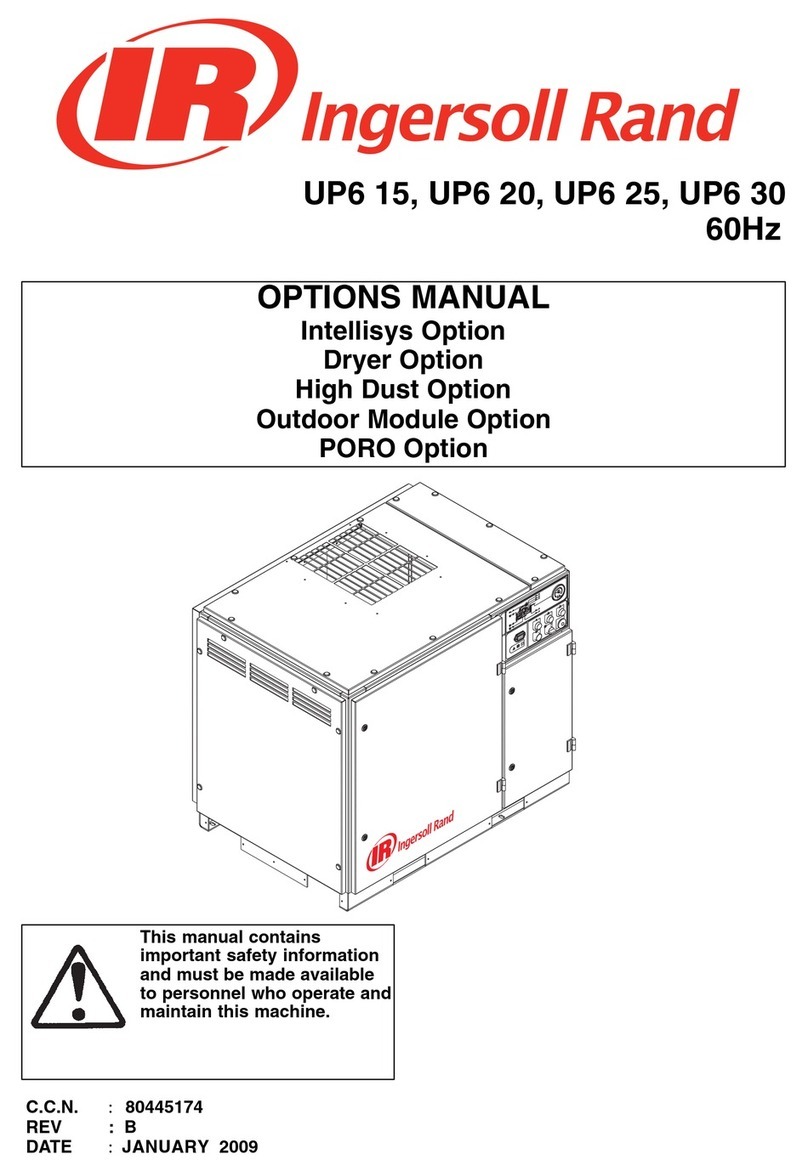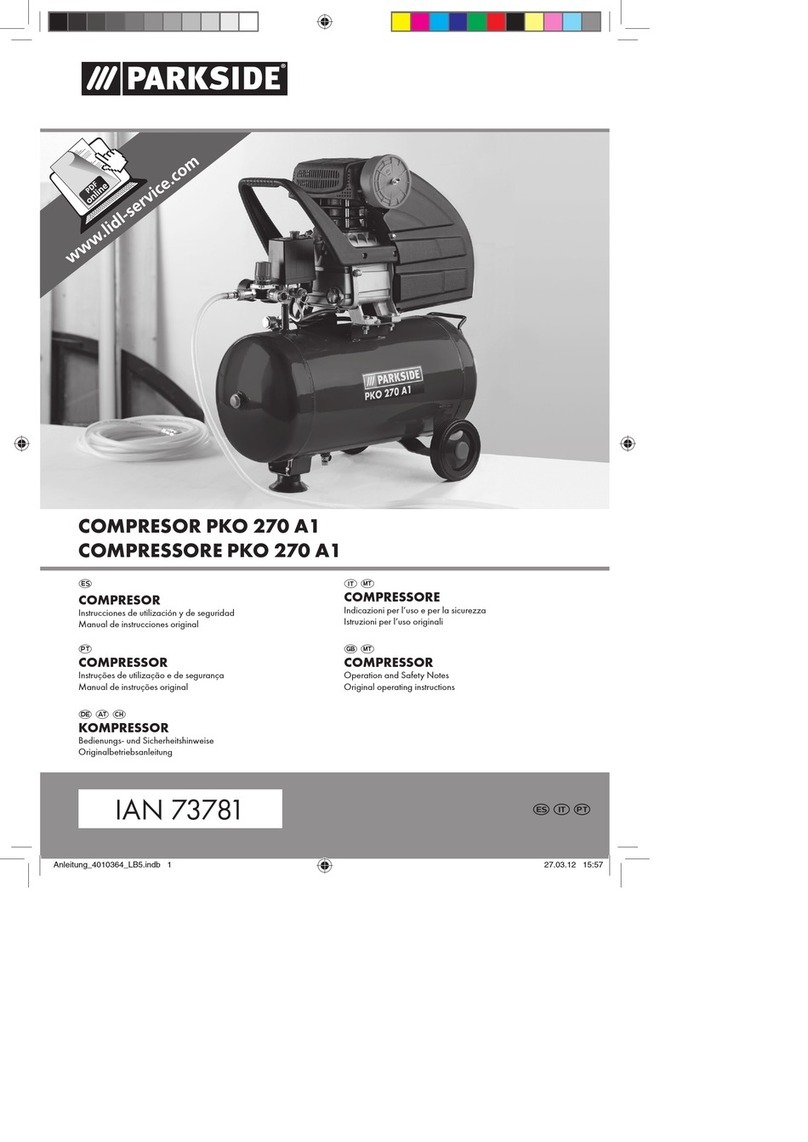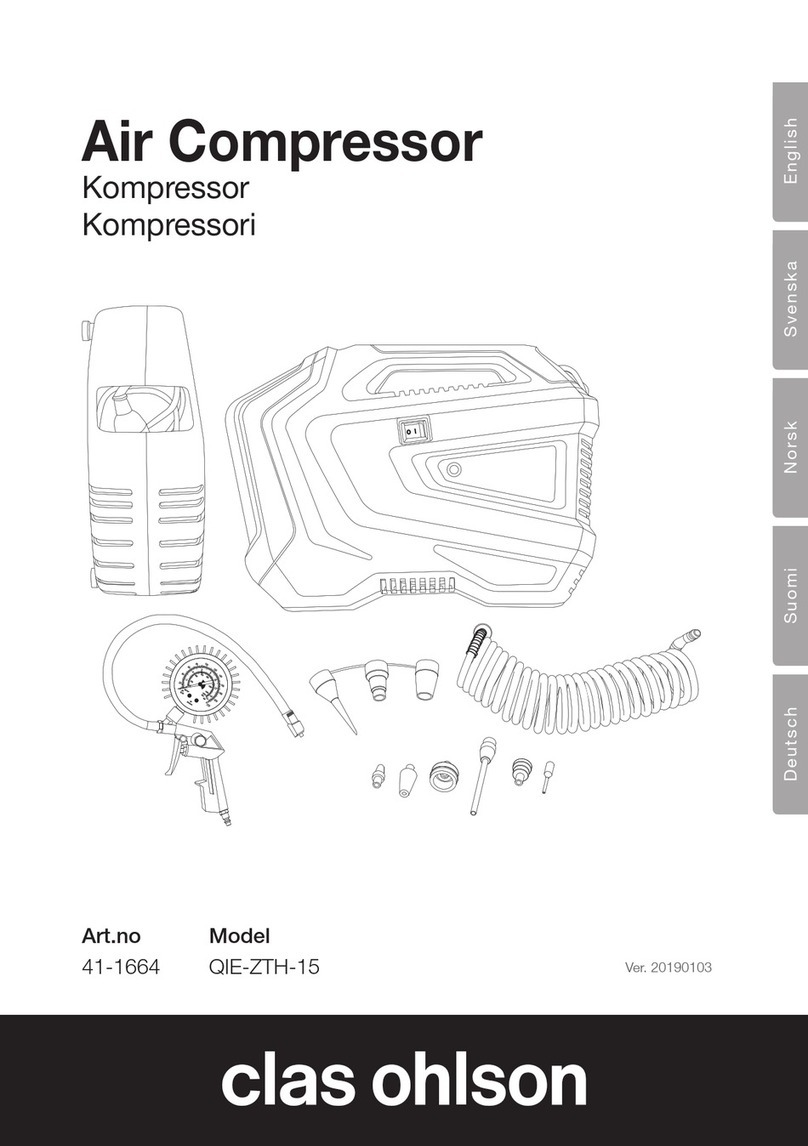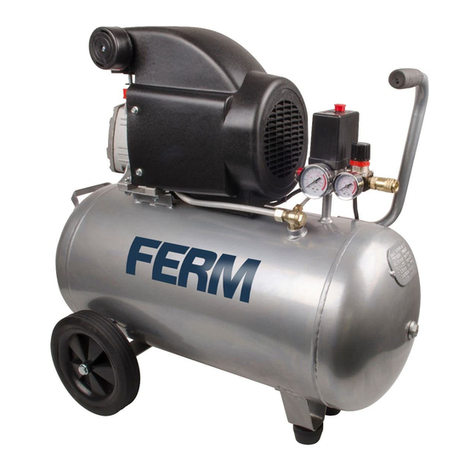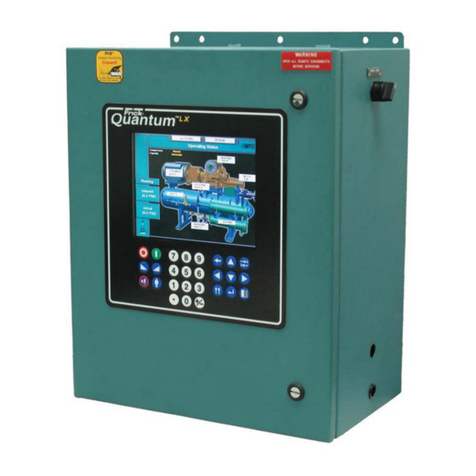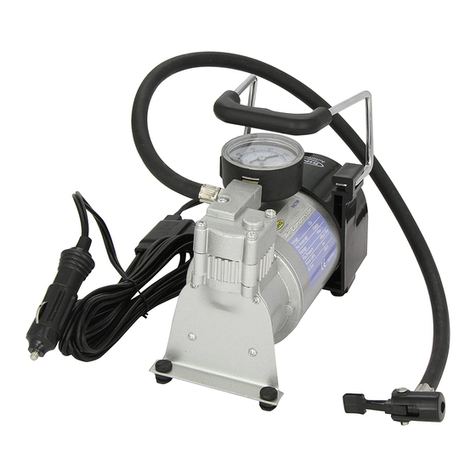Husky H301PL User manual

SAVE THIS MANUAL FOR FUTURE REFERENCE
WARNING: To reduce the risk of injury, the user
must read and understand the operator’s manual before
using this product.
Your aircompressorhasbeenengineeredandmanufactured
to our high standard for dependability, ease of operation,
and operator safety. When properly cared for, it will give you
years of rugged, trouble-free performance.
Thank you for your purchase.
GUARDE ESTE MANUAL PARA FUTURAS CONSULTAS
Su compresor de aire ha sido diseñada y fabricada de
conformidad con nuestras estrictas normas para brindar
fiabilidad, facilidad de uso y seguridad para el operador.
Con el debido cuidado, le brindará muchos años de sólido
y eficiente funcionamiento.
Le agradecemos su compra.
ADVERTENCIA: Para reducir el riesgo de
lesiones, el usuario debe leer y comprender el manual
del operador antes de usar este producto..
OPERATOR’S MANUAL
MANUAL DEL OPERADOR
3 GALLON AIR COMPRESSOR
3 GALONES COMPRESOR DE AIRE
H301PL

2 - English
TABLE OF CONTENTS / INDICE DE CONTENIDO
INTRODUCTION / INTRODUCCIóN
This product has many features for making its use more pleasant and enjoyable. Safety, performance, and dependability
have been given top priority in the design of this product, making it easy to maintain and operate.
***
Esta producto ofrece numerosas características para hacer más agradable y placentero su uso. En el diseño de este
producto se ha conferido prioridad a la seguridad, el desempeño y la fiabilidad, por lo cual se facilita su manejo
y mantenimiento.
Introduction......................................................................................................................................................................2
Introducción
General Safety Rules ................................................................................................................................................... 3-4
Reglas de seguridad generales
Specific Safety Rules................................................................................................................................................... 4-5
Reglas de seguridad específicas
Symbols....................................................................................................................................................................... 6-7
Símbolos
Electrical ..........................................................................................................................................................................8
Aspectos eléctricos
Glossary of Terms............................................................................................................................................................9
Glosario de términos
Features..................................................................................................................................................................... 9-10
Características
Assembly ................................................................................................................................................................. 10-11
Armado
Operation................................................................................................................................................................. 11-14
Funcionamiento
Maintenance ..................................................................................................................................................................14
Mantenimiento
Accessories ...................................................................................................................................................................15
Accesorios
Troubleshooting .............................................................................................................................................................16
Corrección de problemas
Warranty ........................................................................................................................................................................17
Garantía
Figure numbers (illustrations)................................................................................................................................... 18-20
Figura numeras (illustraciones)
Customer Service Information......................................................................................................................... Back Page
Información sobre servicio al consumidor..................................................................................................Pág. posterior

3 - English
DANGER:
READ AND UNDERSTAND TOOL LABELS AND
MANUAL. Failure to follow warnings could result in
DEATH or SERIOUS INJURY.
SAVE THESE INSTRUCTIONS
WORK AREA
Keep your work area clean and well lit. Cluttered
benches and dark areas invite accidents. Floor must not
be slippery from wax or dust.
Do not operate power tools in explosive atmospheres,
such as in the presence of flammable liquids, gases,
or dust. Power tools create sparks which may ignite the
dust or fumes.
Keep bystanders, children, and visitors away while op-
erating tools. Distractions can cause you to lose control.
Operate air compressor in an open area at least 18 in.
away from any wall or object that could restrict the
flow of fresh air to ventilation openings.
ELECTRICAL SAFETY
Avoid body contact with grounded surfaces such as
pipes, radiators, ranges, and refrigerators. There is an
increased risk of electric shock if your body is grounded.
Don’t expose power tools to rain or wet conditions.
Water entering a power tool will increase the risk of elec-
tric shock.
Do not abuse the cord. Never use the cord to carry the
tool or pull the plug from an outlet. Keep cord away
from heat, oil, sharp edges, or moving parts. Replace
damaged cords immediately. Damaged cords increase
the risk of electric shock.
When operating a power tool outside, use an outdoor
extension cord marked “W-A” or “W”. These cords are
rated for outdoor use and reduce the risk of electric shock.
PERSONAL SAFETY
Use safety equipment. Always wear eye protection.
Dust mask, nonskid safety shoes, hard hat, or hearing
protection must be used for appropriate conditions.
Eye protection which conforms to ANSI specifications
and provides protection against flying particles both
from the FRONT and SIDE should ALWAYS be worn
by the operator and others in the work area when
loading, operating, or servicing this tool. Eye protection
is required to guard against flying fasteners and debris,
which could cause severe eye injury.
The employer and/or user must ensure that proper
eye protection is worn. We recommend a Wide Vision
Safety Mask for use over eyeglasses or standard safety
glasses that provide protection against flying particles
both from the front and side. Always use eye protection
which is marked to comply with ANSI Z87.1.
Additional safety protection will be required in some
environments. For example, the working area may in-
clude exposure to a noise level which can lead to hearing
damage. The employer and user must ensure that any
necessary hearing protection is provided and used by the
operator and others in the work area. Some environments
will require the use of head protection equipment. When
required, the employer and user must ensure that head
protection marked to comply with ANSI Z89.1 is used.
Stay alert, watch what you are doing, and use common
sense when operating a power tool. Do not use tool
while tired or under the influence of drugs, alcohol,
or medication. A moment of inattention while operating
power tools may result in serious personal injury.
Dress properly. Do not wear loose clothing or jewelry.
Contain long hair. Keep your hair, clothing, and gloves
away from moving parts. Loose clothes, jewelry, or long
hair can be caught in moving parts.
Do not overreach. Keep proper footing and balance
at all times. Proper footing and balance enables better
control of the tool in unexpected situations.
Do not use on a ladder or unstable support. Stable
footing on a solid surface enables better control of the
tool in unexpected situations.
TOOL USE AND CARE
Do not exceed the pressure rating of any component
in the system.
Protect material lines and air lines from damage or
puncture. Keep hose and power cord away from sharp
objects, chemical spills, oil, solvents, and wet floors.
Check hoses for weak or worn condition before each
use, making certain all connections are secure. Do not
use if defect is found. Purchase a new hose or notify an
authorized service center for examination or repair.
Release all pressures within the system slowly. Dust
and debris may be harmful.
Store idle tools out of the reach of children and other
untrained persons. Tools are dangerous in the hands of
untrained users.
Maintain tools with care. Follow maintenance instruc-
tions. Properly maintained tools are easier to control.
Check for misalignment or binding of moving parts,
breakage of parts, and any other condition that may
affect the tool’s operation. If damaged, have the tool
serviced before using. Many accidents are caused by
poorly maintained tools.
Never point any tool toward yourself or others.
GENERAL SAFETY RULES

4 - English
GENERAL SAFETY RULES
Keep the exterior of the air compressor dry, clean, and
free from oil and grease. Always use a clean cloth when
cleaning. Never use brake fluids, gasoline, petroleum-
based products, or any strong solvents to clean the unit.
Following this rule will reduce the risk of deterioration of
the enclosure plastic.
SERVICE
Tool service must be performed only by qualified re-
pair personnel. Service or maintenance performed by
unqualified personnel may result in a risk of injury.
Disconnect power supply, open drain valve to de-
compress tank and allow water to drain, and allow
air compressor to become cool to the touch before
servicing. Turn pressure regulator knob fully counter-
clockwise after shutting off compressor.
When servicing a tool, use only identical replacement
parts. Follow instructions in the Maintenance section
of this manual. Use of unauthorized parts or failure to
follow Maintenance instructions may create a risk of
injury.
SPECIFIC SAFETY RULES
Know your air compressor. Read operator’s manual
carefully. Learn its applications and limitations, as well
as the specific potential hazards related to this tool.
Following this rule will reduce the risk of electric shock,
fire, or serious injury.
Drain tank of moisture after each day’s use.
If unit will not be used for a while, it is best to leave drain
valve open until such time as it is to be used. This will
allow moisture to completely drain out and help prevent
corrosion on the inside of tank.
Risk of Fire or Explosion. Do not spray flammable liquid
in a confined area. Spray area must be well ventilated. Do
not smoke while spraying or spray where spark or flame
is present. Keep compressors as far from the spraying
area as possible, at least 15 feet from the spraying area
and all explosive vapors.
Risk of Bursting.
Do not adjust regulator to result in
output pressure greater than marked maximum pressure
of attachment and/or the item being inflated. Never use
at pressure greater than 135 psi.
Use an air pressure gauge periodically while inflating
an item to check the air pressure.
If connected to a circuit protected by fuses, use time-
delay fuses with this product.
To reduce the risk of electric shock, do not expose to
rain. Store indoors.
Inspect tank yearly for rust, pin holes, or other
imperfections that could cause it to become unsafe.
Never weld or drill holes in the air tank.
Make sure the hose is free of obstructions or snags.
Entangled or snarled hoses can cause loss of balance or
footing and may become damaged.
Use the air compressor only for its intended use. Do
not alter or modify the unit from the original design
or function.
Always be aware that misuse and improper handling
of this tool can cause injury to yourself and others.
Do not place over 250lbs on the work seat. Doing so
could result in damage to the tool.
Never step or stand on the work seat. Following this
rule will reduce the risk of serious personal injury.
To reduce the risk of personal injury, do not use work
seat as a step or platform.
Never leave a tool unattended with the coil air hose
attached.
Do not operate this tool if it does not contain a legible
warning label.
Do not continue to use a tool or hose that leaks air or
does not function properly.
Always disconnect the air supply and power supply
before making adjustments, servicing a tool, or when a
tool is not in use.
Do not attempt to pull or carry the air compressor by
the hose.
Your tool may require more air consumption than this
air compressor is capable of providing.
Always follow all safety rules recommended by the
manufacturer of your air tool, in addition to all safety
rules for the air compressor. Following this rule will
reduce the risk of serious personal injury.
Never direct a jet of compressed air toward people or
animals. Take care not to blow dust and dirt towards
yourself or others. Following this rule will reduce the risk
of serious injury.

5 - English
SPECIFIC SAFETY RULES
Do not use this air compressor to spray chemicals.
Your lungs can be damaged by inhaling toxic fumes. A
respirator may be necessary in dusty environments or
when spraying paint. Do not carry while painting.
Inspect tool cords and hoses periodically and, if
damaged, have repaired at your nearest Authorized
Service Center. Constantly stay aware of cord location.
Following this rule will reduce the risk of electric shock or
fire.
Never use an electrical adaptor with this grounded
plug.
Check damaged parts. Before further use of the air
compressor or air tool, a guard or other part that is
damaged should be carefully checked to determine
that it will operate properly and perform its intended
function. Check for alignment of moving parts, binding
of moving parts, breakage of parts, mounting, and
any other conditions that may affect its operation. A
guard or other part that is damaged should be properly
repaired or replaced by an authorized service center.
Following this rule will reduce the risk of shock, fire, or
serious injury.
Make sure your extension cord is in good condition.
When using an extension cord, be sure to use one
heavy enough to carry the current your product will
draw. A wire gauge size (A.W.G.) of at least 14 is
recommended for an extension cord 25 feet or less in
length. A cord exceeding 50 feet is not recommended.
If in doubt, use the next heavier gauge. The smaller
the gauge number, the heavier the cord. An undersized
cord will cause a drop in line voltage resulting in loss of
power and overheating.
This equipment incorporates parts, such as snap
switches, receptacles, and the like that tend to pro-
duce arcs or sparks and, therefore, when located in a
garage, it should be in a room or enclosure provided for
the purpose, or should be 18 in. (457 mm) or more above
the floor.
Never store tool with air connected. Storing the tool
with air connected can result in unexpected firing and
possible serious personal injury.
Protect your lungs. Wear a face or dust mask if the
operation is dusty. Following this rule will reduce the risk
of serious personal injury.
Do not operate coil air hoses above the rated psi. Fol-
lowing this rule will reduce the risk of serious personal
injury.
Ifthe powersupplycordis damaged,itmustbe replaced
only by the manufacturer or by an authorized service
center to avoid risk.
Save these instructions. Refer to them frequently and use
them to instruct others who may use this tool. If you loan
someone this tool, loan them these instructions also.
Table of contents
Languages:
Other Husky Air Compressor manuals

Husky
Husky 395-226 User manual

Husky
Husky 2G110DPNG User manual
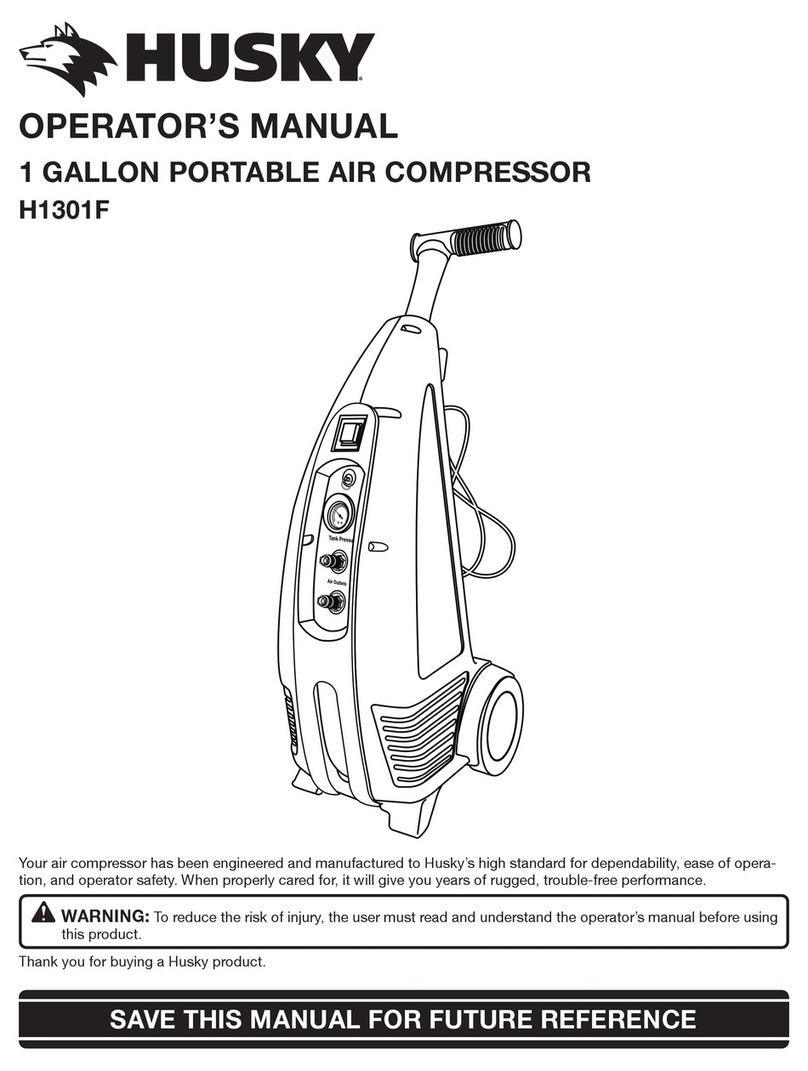
Husky
Husky H1301F User manual
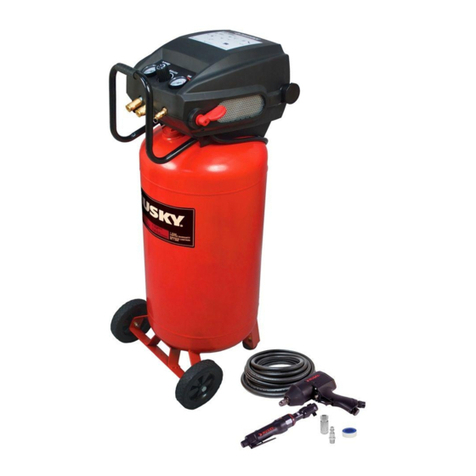
Husky
Husky 671-049 User manual
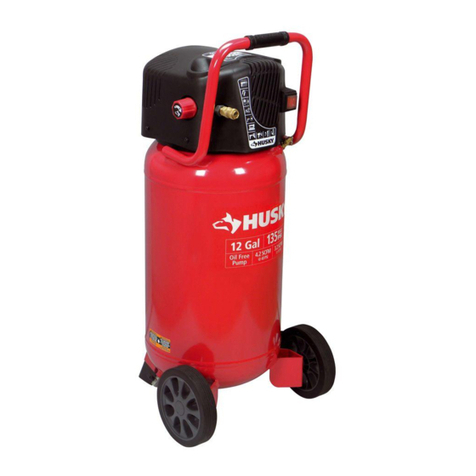
Husky
Husky H15123TK User manual
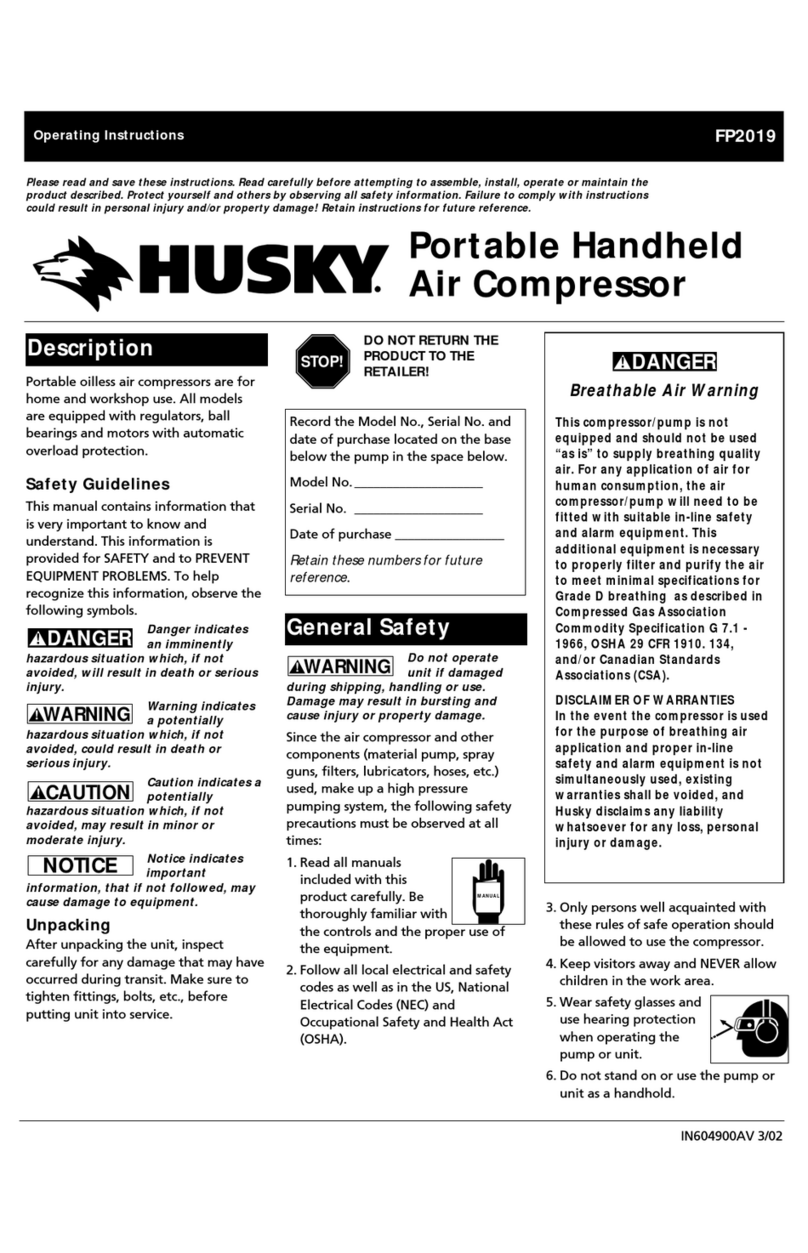
Husky
Husky FP2019 User manual
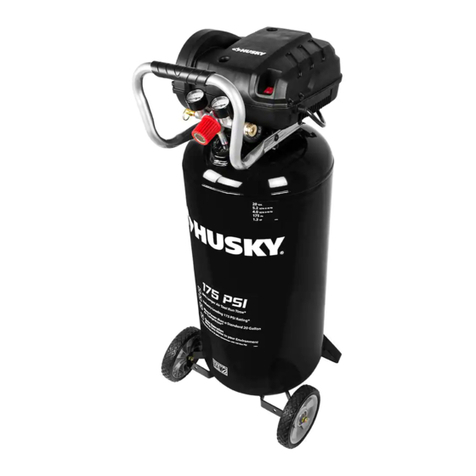
Husky
Husky C201H User manual
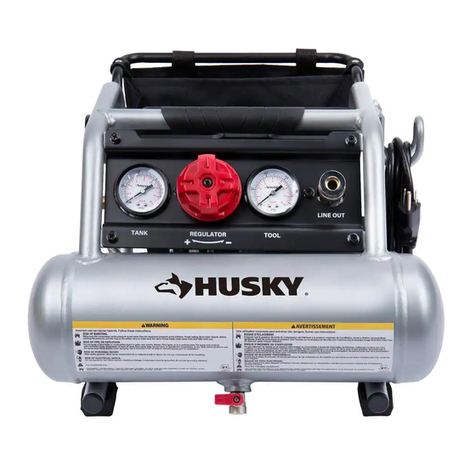
Husky
Husky 3300113 User manual
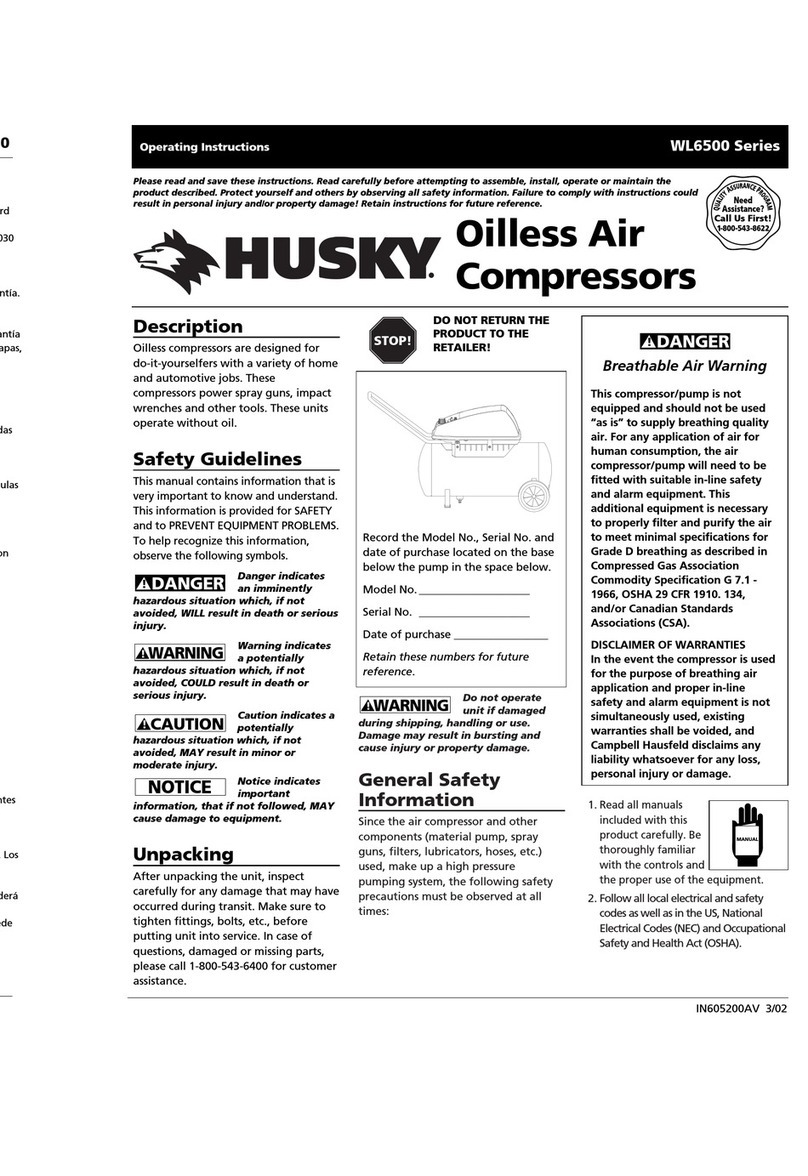
Husky
Husky WL6500 Series User manual

Husky
Husky Y1000 User manual
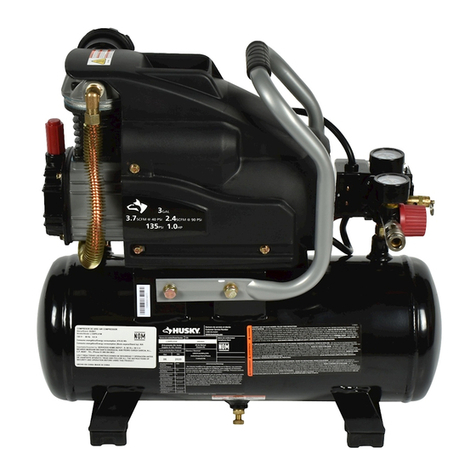
Husky
Husky L13HPD.01 User manual
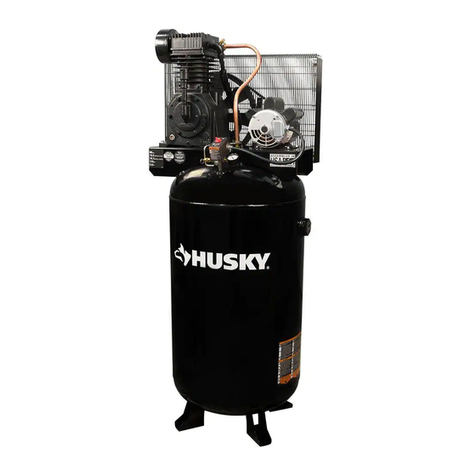
Husky
Husky C803H User manual

Husky
Husky 835-522 User manual
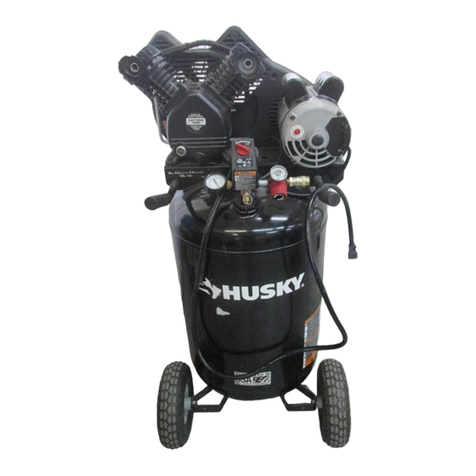
Husky
Husky C301H User manual
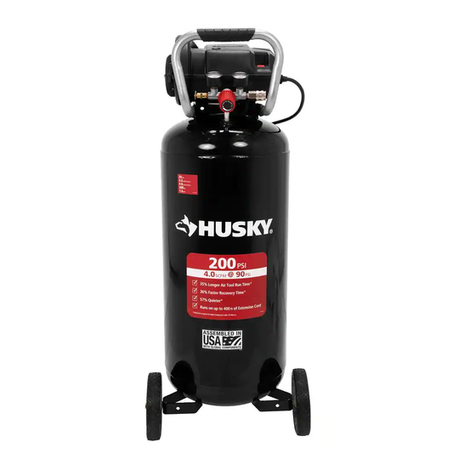
Husky
Husky C202H User manual
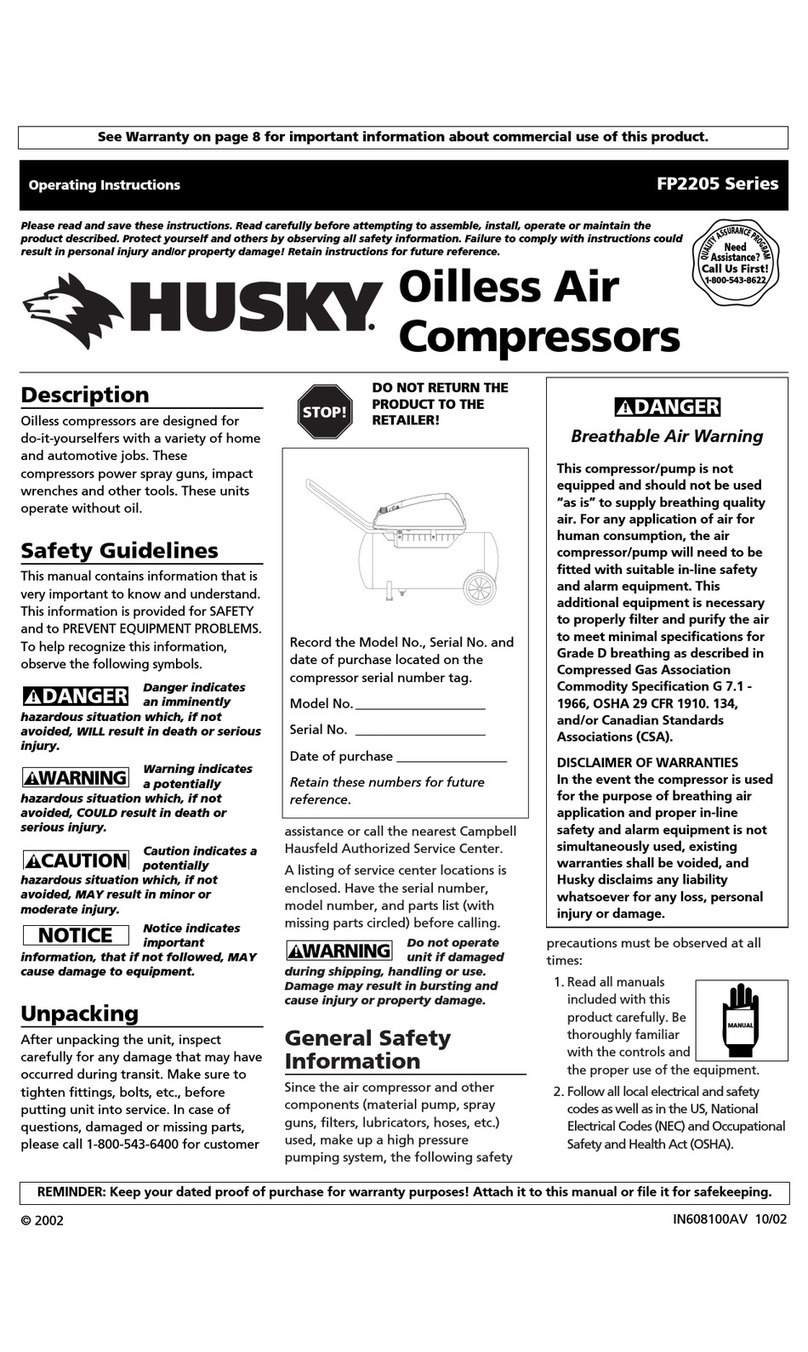
Husky
Husky FP2205 Series User manual
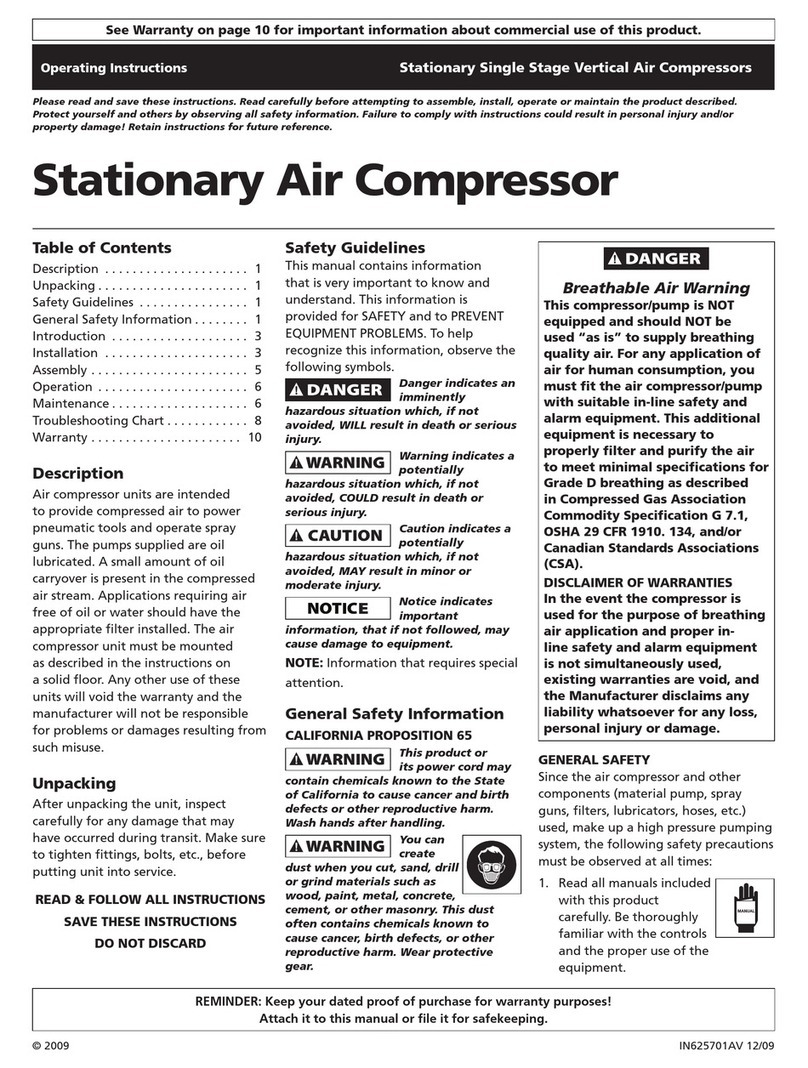
Husky
Husky VT631402AJ User manual
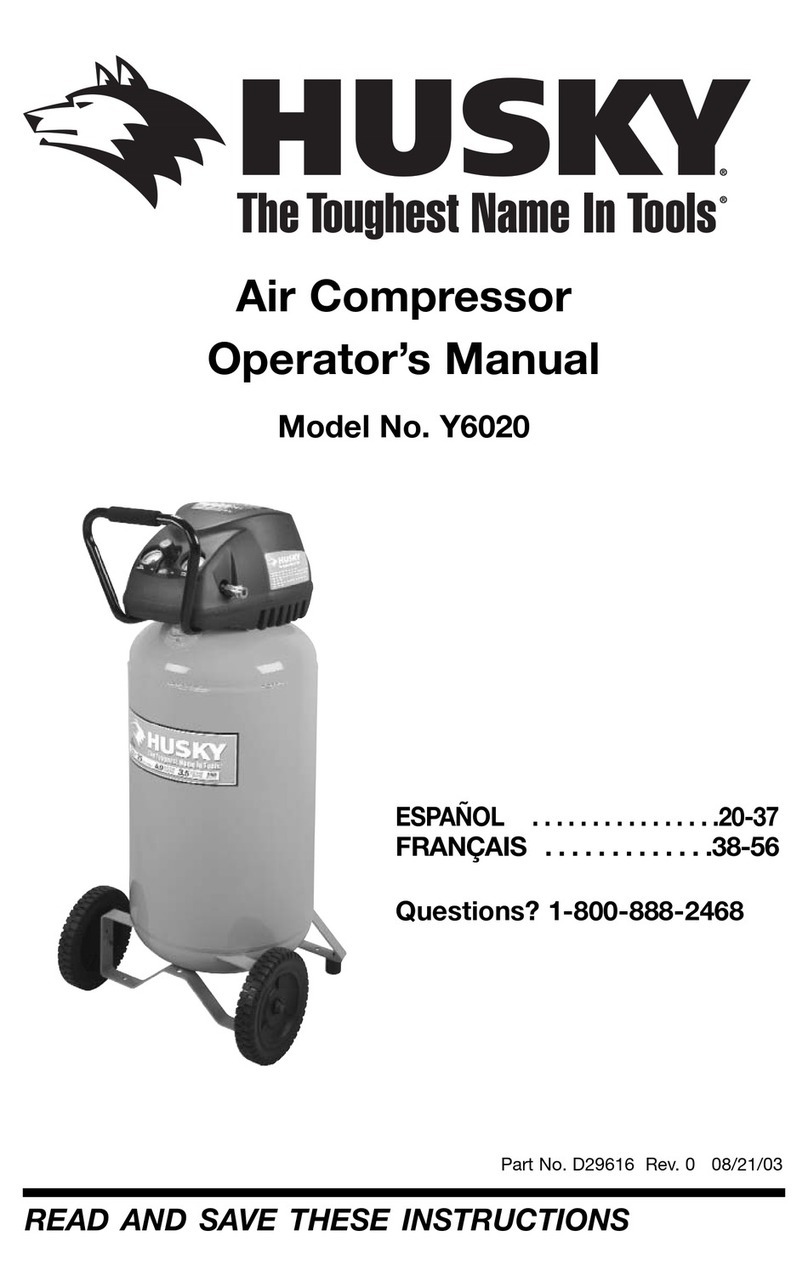
Husky
Husky D29616 User manual
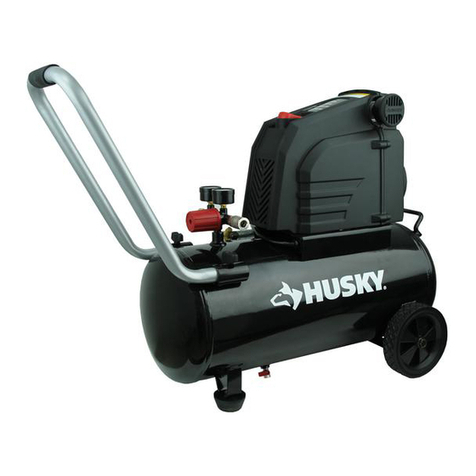
Husky
Husky 0300813A User manual
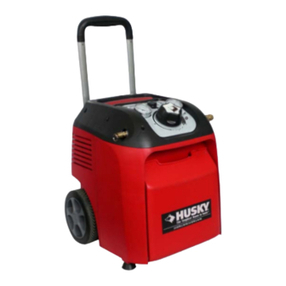
Husky
Husky 41214 User manual

